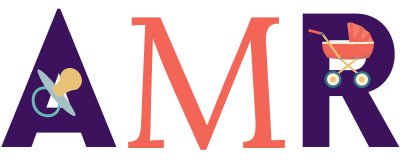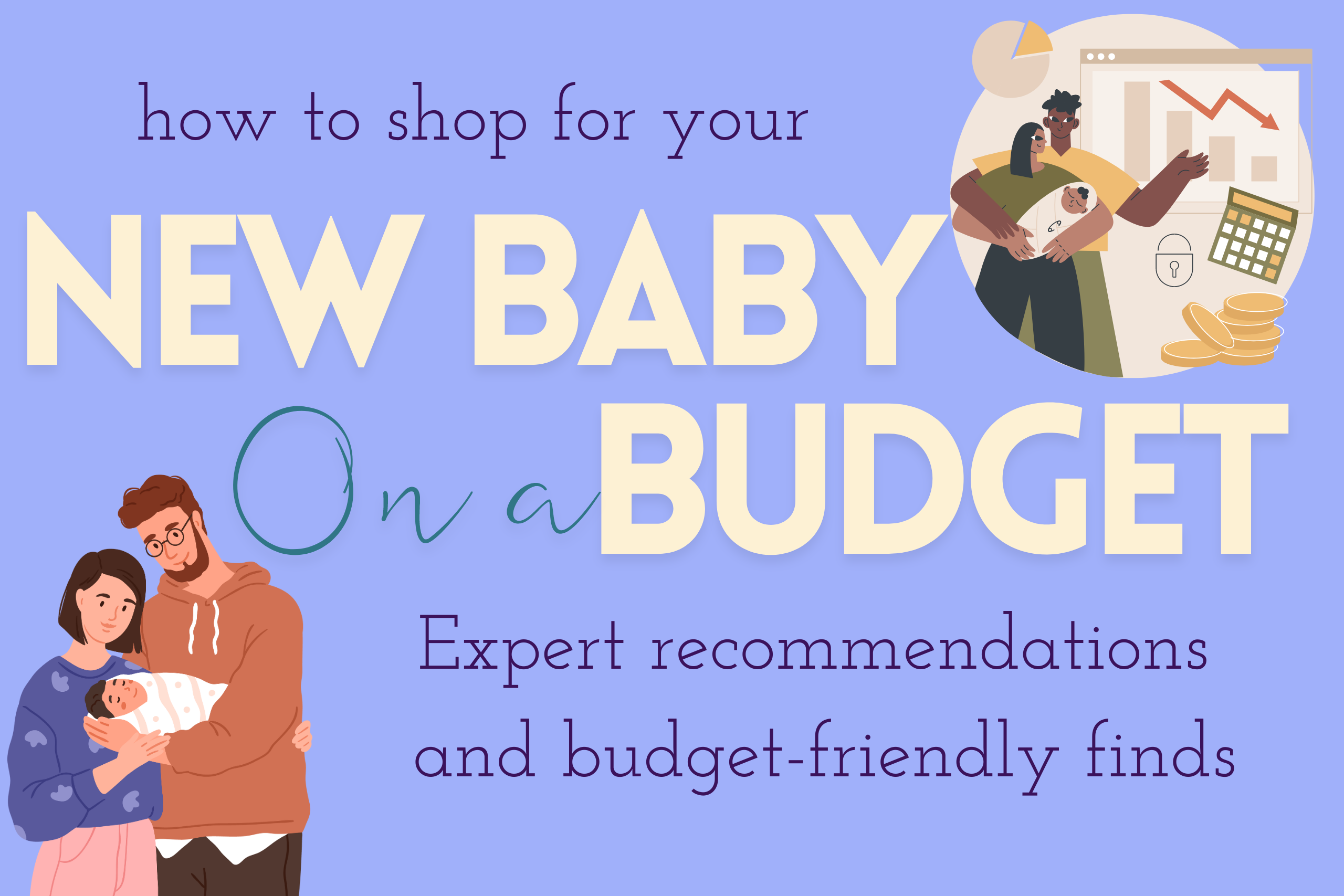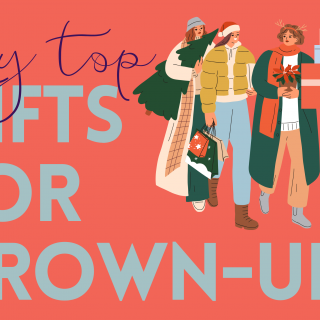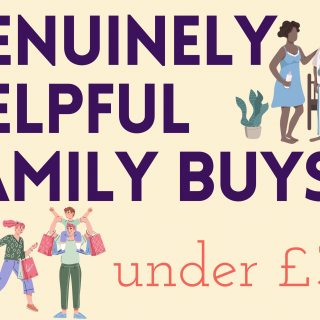Shopping for a new baby can get really expensive really quickly. Everybody wants your money and will tell you that their product is the indispensable thing that’s going to change your life as a parent. But a lot of the time you can do without a huge amount of items that are being marketed to you.
This list is my most straightforward, for people who are on a tight budget and looking for an honest guide to reliable products at competitive prices from trusted brands.
I’ve included only the very basics: sleep, transport and basic hygiene items. I realise personal requirements differ (you may be planning to exclusively baby wear rather than buying a pram, for example) but or the sake of ease I’m assuming that most people reading this are looking for help with the major big ticket items – a cot or crib, a pram/pushchair, a car seat etc. I’ve not included feeding items, but will be covering this in future guides.
A Mum Recommends uses affiliate links. This means I might receive commission if you click on my links and go on to make purchases. However, please be assured this does not impact my product choices or recommendations.
Skip to the good part:
- Cots and cribs
- Pushchairs and prams
- Car seats
- Baby Carriers
- Baby monitors
- Sterilisers
- NappieS & WIPEs
Shopping for second-hand baby items
The good news for those on a budget is that 90% of the things that you need for your child can be acquired second hand. A lot of high-ticket baby items are used for less than a year, sometimes less than 6 months, and most have plenty of life in them after this.There are loads of places that you can look to start your second-hand search:
- Charity shops
- Facebook marketplace / freebie groups
- Vinted
- eBay
- Car boot sales
- NCT nearly new sales
- School jumble sales
- Mum 2 Mum market sales
Keep an eye on notice boards in supermarkets, church halls, hospitals and community centres for sale events in your local area. If you live in a residential area, take a walk on bank holidays and warm weekends in case anyone is doing a clear-out and leaving items outside their house for free. I’ve found some amazing toys this way!
If you’re really struggling to make ends meet, there is further help out there from support groups, charities and baby banks, and there is no shame in seeking it out. In most cases you will need a referral, so speak to your GP, midwife or health visitor first. You can visit the website of the amazing Baby Bank Alliance to find a map of all the major baby banks across the UK.
Items you must buy new for your baby
There are two big ticket items that you should not buy second hand for safety reasons. These are your car seat, and your baby’s mattress.
Other small items that go in the mouth like bottle teats, teethers and dummies should also be new. Most other items are usually fine to buy second hand.
Why can’t I use a second-hand mattress for my baby?
A new mattress should be purchased for your child’s safety and your reassurance. Second-hand mattresses have been linked to an increased risk of SIDS (Sudden Infant Death Syndrome) so organisations like The Lullaby Trust advise you buy a brand new one for each baby.
This includes mattresses for bedside cribs, moses baskets and newborn cribs, as well as larger cot and cotbed mattresses. If you’re buying a second-hand pram and plan to do lots of naps on the go, it is probably worth seeing if you can buy a replacement mattress for this too.
The good news is that mattresses are not hugely expensive compared to what you’d pay for an adult one. At John Lewis, for example, you can get a new mattress for a Moses basket for £12, and a full size cot mattress for £28. If you want to keep costs down, ensure your cot takes a standard size of mattress (60 x 120cm for a cot or 70 x 140cm for a cotbed). Some brands make their items a little wider, deeper or narrower so you have to buy their branded mattress to match (often at an inflated price).
Why can’t I use a second-hand car seat for my baby?
It’s advisable not to purchase a second-hand car seat because you cannot guarantee the history of that seat, therefore you won’t know if it’s been in a collision. Any car seat that has been involved in an accident/collision must be disposed of as it may be damaged. Sometimes this damage isn’t visible from the outside, but even a seemingly small bump can affect the internal integrity of the seat.
I know that car seats are expensive and acquiring one brand new is costly, but in this case the safety of your baby is paramount and it has to take priority in your budget. If you’re going to drive with your baby in a car, your car seat should be where any budget you do have goes.
You may think it’s acceptable to use a second hand car seat if you are 100% confident that the seat has not been involved in an accident – if it comes from a close friend or family member who you fully trust, for example. There is no legislation that stops you from doing this, but there should be a manufacturer’s recommended service life printed on the seat – a bit like a “best before” for the seat. This is not a legal expiration date like in some other countries, but it should be considered. Old car seats that have been in storage for years may have exceeded this lifespan. They also won’t be up to date with the most recent safety updates and innovations, which are always evolving.
1. A cot, crib or sleep space
According to UK organisations such as the Lullaby Trust, the NHS and the NCT, the safest place for a newborn baby to sleep is in the same room as you, put down on their back in their own dedicated sleep space, such as a moses basket, crib or cot. For this reason, my recommendations are products that will allow you to follow this guidance.
What about co-sleeping?
Co-sleeping is when you bring your baby into your own bed and sleep together with them. The NCT reports that as many as half of all families in the UK will have co-slept to some extent in the first 6 months and it’s very natural to want to do it, especially if your baby won’t sleep easily in a cot or crib. If you do co-sleep, just remember there are some important guidelines you must follow. You should not co-sleep if any adult sharing the bed smokes, has been drinking alcohol or has taken drugs.
There is no one size fits all approach to baby sleep, and you must do what’s right for your family. My product recommendations below assume you will be trying – at least some of the time – to have your child sleep independently. This is simply because you are unlikely to need any new equipment if you intend to co-sleep.

Your main options for a sleep space for a newborn baby are a moses basket, a crib or bedside crib, a cot/cotbed, or a carrycot.
A traditional Moses basket is compact and easy to move around. However, they’re seldom the best option if you’re on a budget, as babies can outgrow one in a matter of months. I’ve included one in my list just in case, though.
A newborn crib is a smaller, more portable sleep space that’s suitable until around 6 months (maxing out at 9kg). They usually consist of a metal or wooden frame with fabric sides, and may also have extra elements like rocking functionality, adjustable heights and so on. Like Moses baskets, cribs have limited longevity, but usually include more features.
Bedside cribs (sometimes called “co-sleepers” or “next to me” cribs) fasten to the side of your bed and have a drop-down side to allow for easy access to the baby. These are amazing if you’re breastfeeding or recovering from a c-section and are the closest thing to co-sleeping while maintaining a separate space for the baby. Although not the cheapest option I’ve include these in my list as they’re a very popular product, and great for space-saving in a small room in those early months.
Although your newborn may look tiny in it to start with, a full sized cot or cotbed can be used from birth, and it will last until you feel your child is ready to move to a bed (which could be anything from 18 months to age 3). If you have room for a cot in your bedroom, getting one straight away and doing without a moses basket or crib will save you money. Many come with the option to put the mattress higher up to avoid having to bend down in the early months.
Finally, there’s an often-overlooked repurposing option. The lie-flat, parent-facing newborn carrycot that you use on your pushchair frame can sometimes be used as a permanent sleep space too. If this is something you’re interested in, check the product description carefully – not all carrycots are designed for this type of use, and it’s often pricier brands that offer this functionality.
Why aren’t all carrycots suitable for overnight sleep?
If it’s fine for your baby to sleep in a pram while you’re out in the day, why is it not suitable for sleep at home too? There are a few reasons: firstly, babies in prams are mostly being supervised. At night you’ll be asleep too (hopefully) so you won’t be supervising in the same way even if the baby is in the same room as you.
Secondly, most carrycots have simply not been designed or tested for this type of use, so it will not be recommended. The mattresses may not be the same as one designed to withstand the levels of use a crib or cot gets. The depth of the carrycot is also key: you’ll notice the ones approved for overnight sleep are extra deep, such as the luxurious UppaBaby carrycot . This protects your baby if they suddenly learn to roll during the night.
Look for the specific phrase “suitable for overnight sleep” in product information provided directly by the manufacturer. Some carrycots are listed as “suitable for occasional overnight sleep” – these work better when you travel, or could be handy if you have a cot permanently upstairs but need somewhere for your baby to nap near you during the day.
My favourite budget cots, cribs and Moses baskets
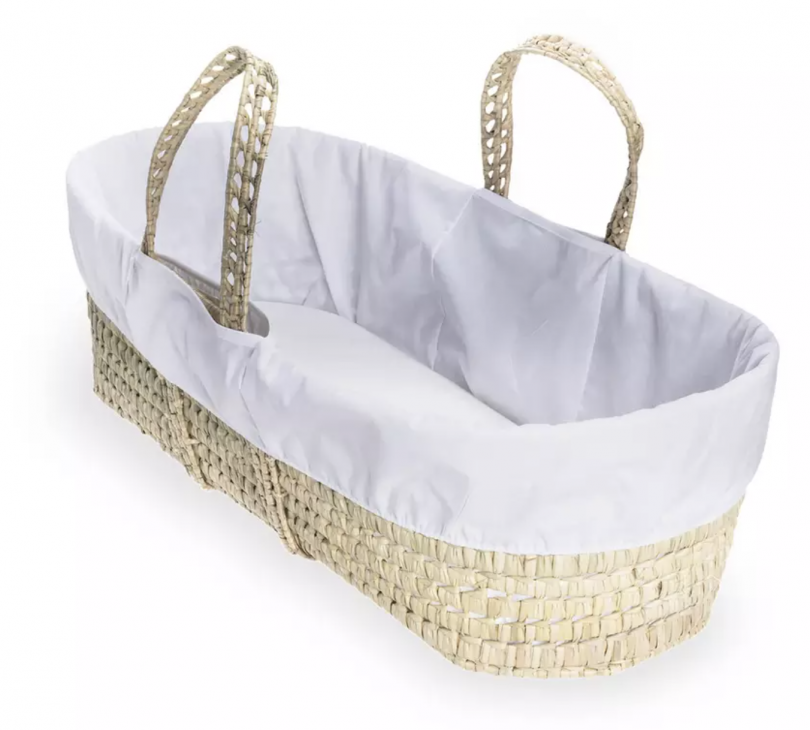
Claire de Lune White Essentials Moses Basket, £30
Claire de Lune makes dozens of different Moses baskets and they’ve always ticked the boxes with the parents I’ve spoken to. This is their most basic “essentials” Moses basket, and at £30 it’s a great entry-level solution for newborn sleep.
You can buy a version with a stand for £45, but it’s also fine to put it on the floor. Don’t leave a Moses basket on a raised surface (especially something soft like a bed or sofa). You also shouldn’t carry it while your baby is in it.
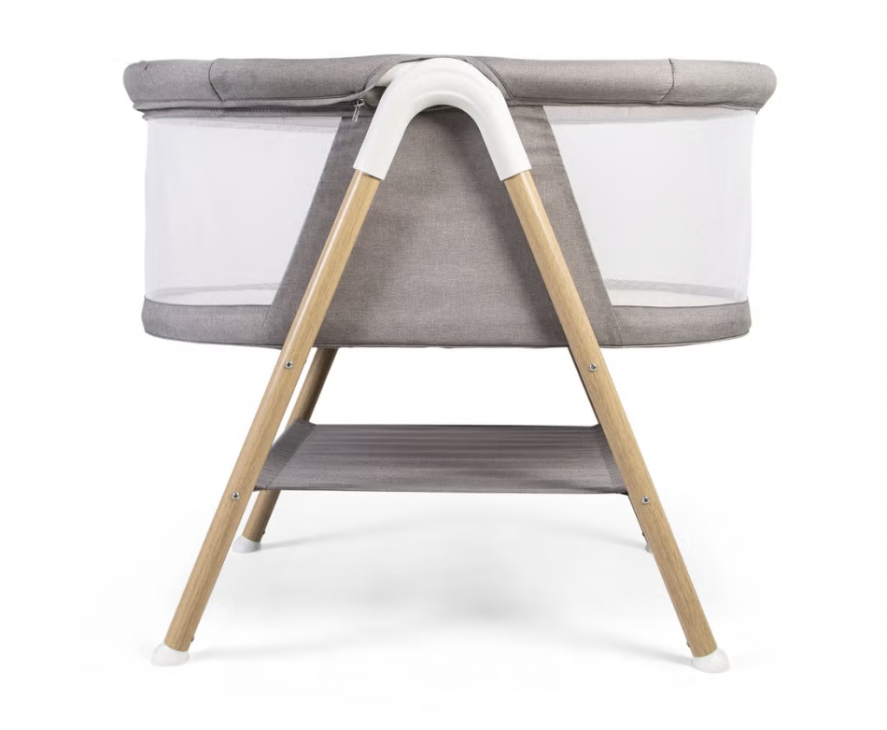
Red Kite Snooze Crib, £55
This is a great value newborn crib with stylish wood-effect trims, a decent mattress and good breathable fabric panels (which also make it easier to see your baby).
It looks like it costs far more than the under-£60 price tag and has a lovely modern look. The storage shelf is a bonus, too – a great place to stash nappies or muslins.
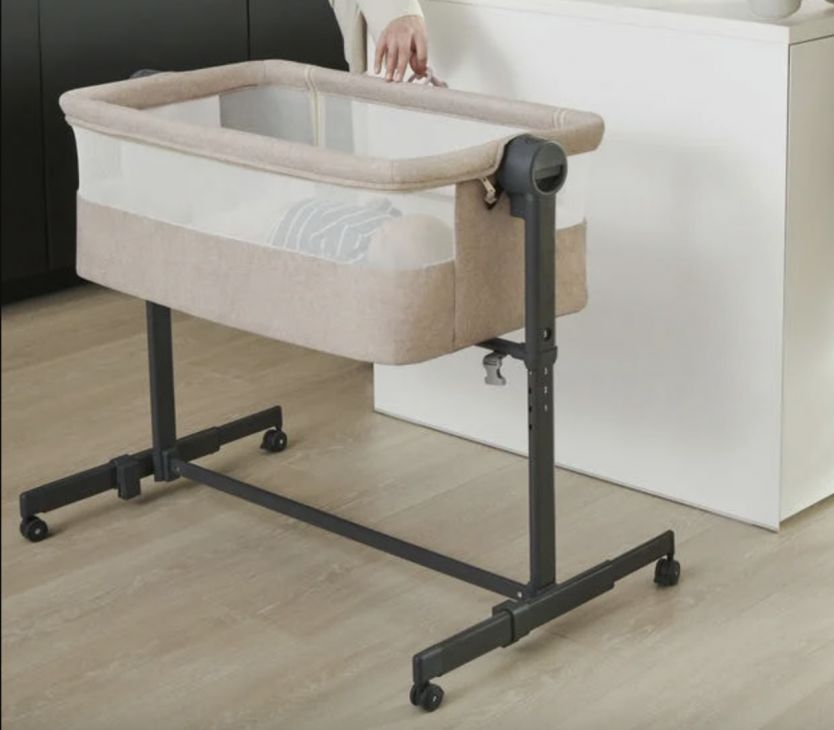
Kinderkraft Neste-up 2 bedside crib, £74.90
A decent bedside crib option for under £100, Kinderkraft’s offering comes on castors to move it around easily.
There are beige or grey colour options, and good height adjustability to ensure a safe and neat fit to your bed. The legs slide easily under a frame or divan bed but do check the length of the straps before purchase if you have the latter.
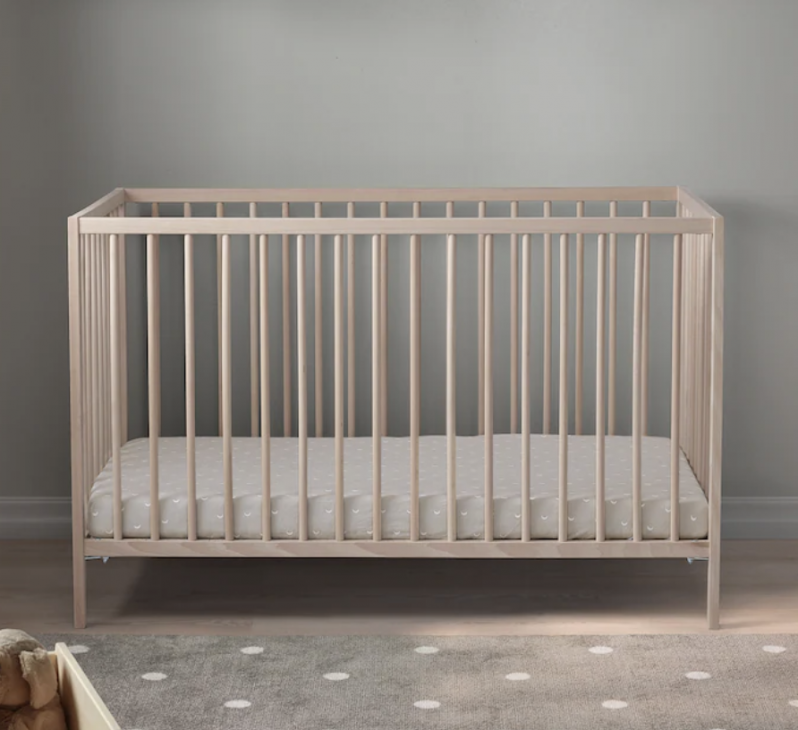
Ikea Sniglar Cot, £59
You know you can trust Ikea to deliver when it comes to simple Scandi design, and this classic cot is a really great find at a low price tag. It has multiple levels so you can raise the mattress for a newborn so they’re easier to take in and out of the cot.
Ikea’s cot mattresses are also good quality if you want the set. This takes a standard 60 x 120 mattress – the cheapest one at Ikea is £49 but John Lewis has one for £28.
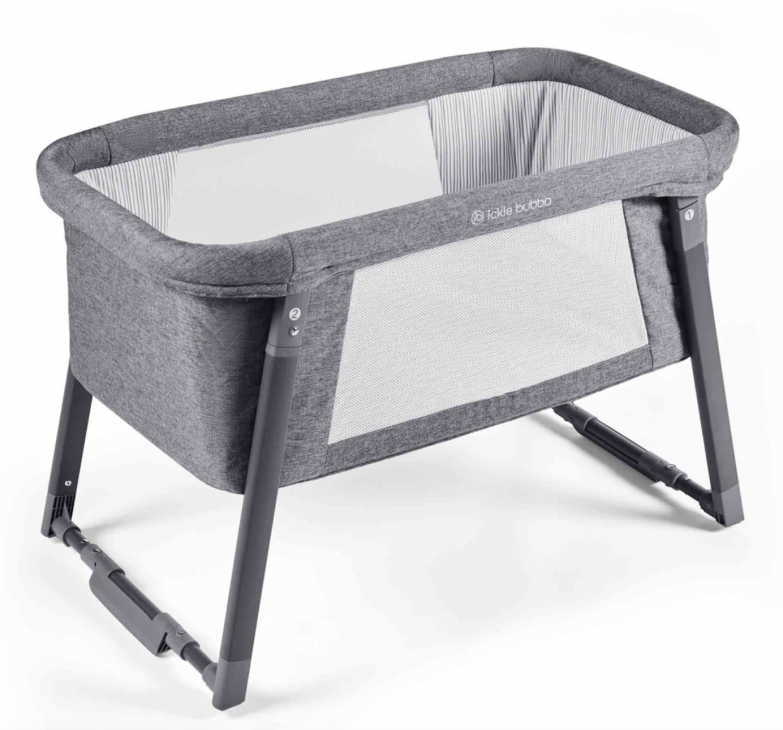
Ickle Bubba Mini Rocker Crib, £99
This crib is super compact and can easily be moved around as it can be collapsed and put in the provided storage bag, making it really handy if your baby sleeps in multiple different spaces with different caregivers.
The built-in rocking function is a lovely addition to help soothe your baby, too. The only thing to note is that this little crib sits quite low to the ground, which may not be comfortable for c-section mums in the early weeks.
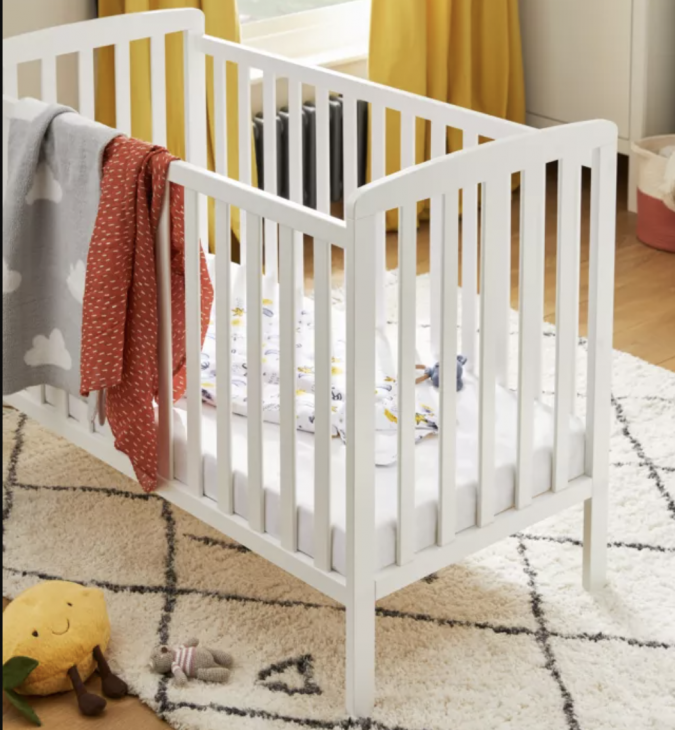
John Lewis Elementary Cotbed, £155
Cotbeds offer the most longevity, which explains why they cost the most at the beginning: this lasts until age 4, vs the 6-month lifespan of most bedside cribs, or cots which probably need to be replaced around age 2. For me a cotbed is the most economical option.
The “bed” element means this is convertible: remove one side when you’re ready and it becomes a cosy toddler daybed. It takes a standard 140 x 70 mattress – John Lewis also sells these, the cheapest is £38.
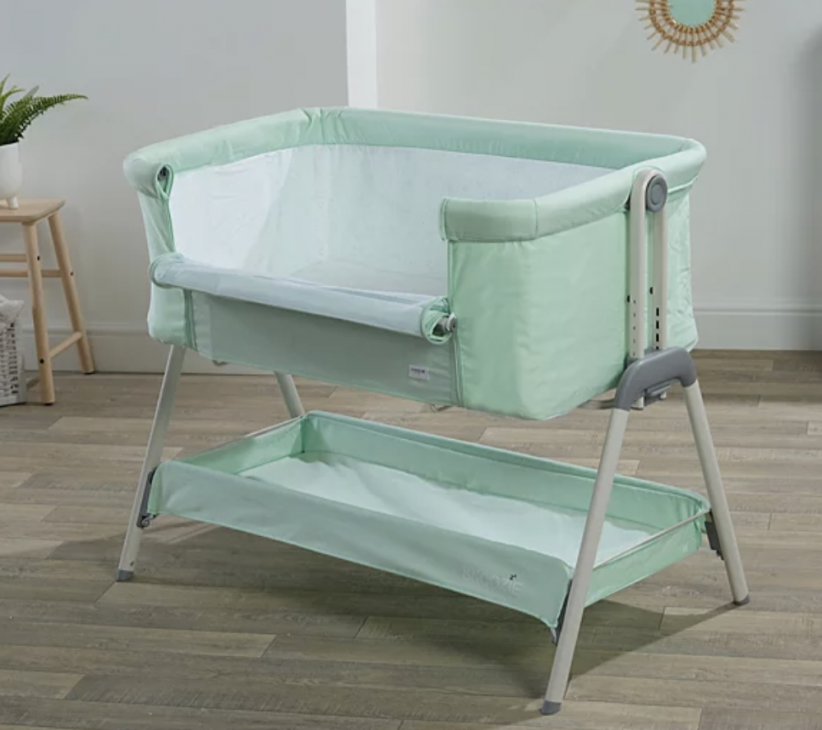
Kinder Valley Snoozie Bedside Crib, £115
Often on offer for under £100 at Argos, this is another bargain bedside crib with all the functionality of a pricier option. The sides don’t have as much breathable mesh as some some other designs, but aside from that it has a lot in common with more expensive “next to me” style cribs.
It also comes in some fun colours I’ve not seen before. The mint green definitely makes a statement.
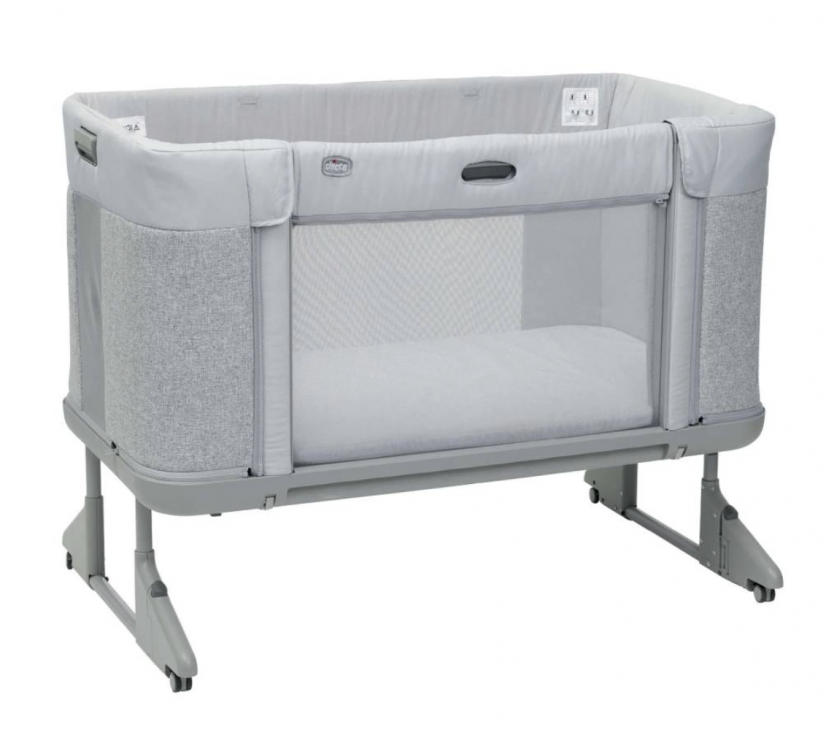
Chicco Next2Me Forever, £299
Although more expensive, I’ve included this because it’s one of few products that functions as both a drop-side bedside crib and a toddler bed, making it suitable from birth to age 4 with the functionality of a co-sleeper crib that many parents want in the early months. Chicco has really led the way in this market and this product is no exception.
You can use the drop-side for longer than other models as it’s a full size cot from birth – this could be amazing if you’re breastfeeding!
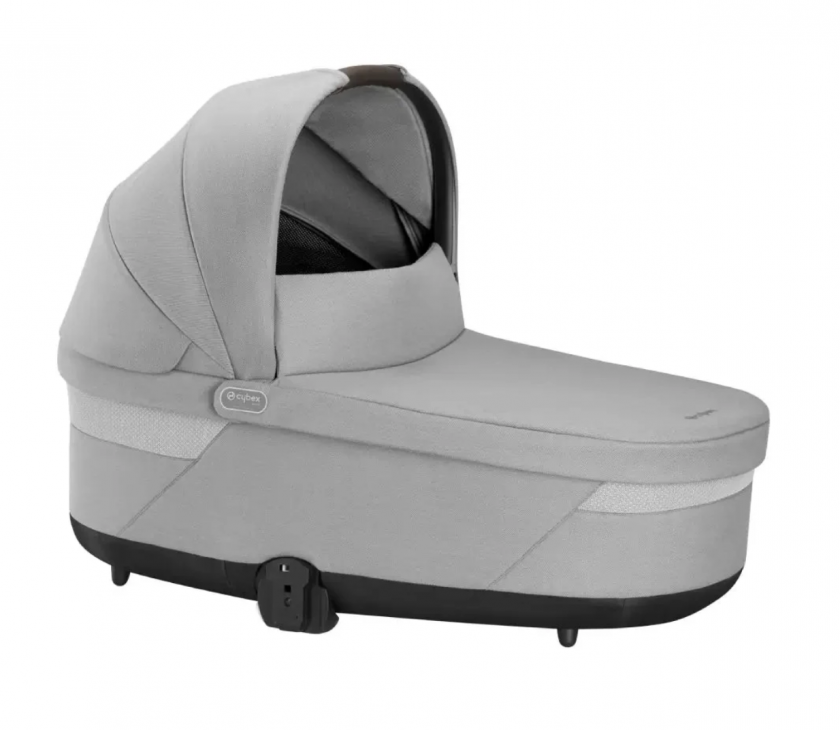
Cybex Cot S Lux, from £179
This carrycot – which is safe for overnight sleep – usually retails for over £250, but I’ve found it in grey for £179, and couldn’t resist including it here as a reminder that a carrycot may double up as a crib if it meets the right spec.
Team it with Cybex’s Balios S Lux pushchair and you can have transport and sleep sorted for your newborn, with great resale potential once your child outgrows it.
2. A pushchair (pram, stroller, buggy)
First-time parents are usually quite shocked when they find out how much pushchairs/prams cost. A newborn buggy from a premium brand like Bugaboo, iCandy or UppaBaby can easily top £1,000. Dior sells a designer buggy for over £5,000. Although you can get a very basic pushchair/stroller to use from 6+ months for as little as £30, it’s harder when shopping for a tiny, fragile newborn. It feels like it’s getting increasingly difficult to find a decent newborn pram with a carrycot from a reputable brand for under £400. But it is doable. You may have to compromise on certain elements and features, but there are some good bargains to be found if you know where to look.
For the first 5-6 months babies in a pram/pushchair should lie completely flat, either in a carrycot or a seat unit with a fully-flat recline – ideally one that faces the parent. There are some strollers that are marketed as being suitable from birth that don’t have a parent-facing option. There’s no law against this, but I rarely meet parents who are comfortable with a world-facing seat in the early months – we want to see our babies as we push them, but it also protects them from overstimulation. For this reason, all my choices have a parent-facing lie-flat seat or carrycot included. This does add to the cost, but I think it’s a must for a newborn. If you’re looking for a budget stroller for an older child, stay tuned for my ultimate pushchair guide soon!
What about a travel system? Do I need one?
A “travel system” simply means that a compatible infant car seat can be clipped onto you pushchair frame (usually using adapters). This is handy for transferring your baby from the car without disturbing them too much, or for short trips. However, a car seat is not really a replacement for a carrycot or a lie-flat seat. It doesn’t keep a baby fully flat and shouldn’t be used for long periods of time outside the car. An infant car seat is a safety item, not a comfort one. If you plan to push your pram for more than about 20 minutes, use a carrycot or lie-flat seat.
Travel systems are convenient, but it’s easy to get caught up in the idea that you have to buy an expensive bundle from one brand. You don’t! Some of the best and most popular infant car seats (like those from Cybex or Maxi-Cosi) use universal adapters that will fit on a wide variety of pushchairs. You may also miss out on the many options for from-birth car seats that stay fitted in your car. They’re not quite as convenient in the early days (although the introduction of 360 swivel has helped) but are often better value long-term. A travel system may be important to you, but do investigate other options, especially if you drive frequently: the car seats in budget bundles tend to be very basic.
My favourite budget newborn pram/pushchairs
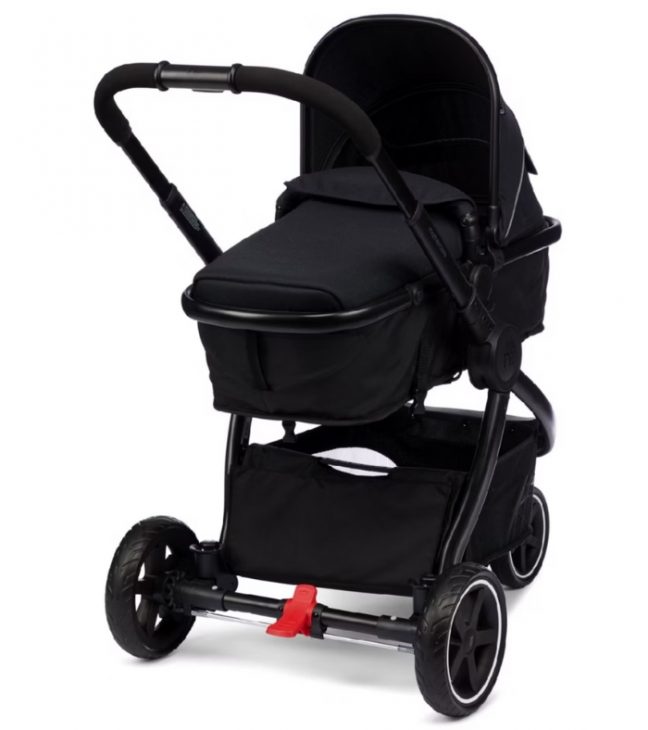
Mothercare Journey, from £150
Starting at £150, the Mothercare journey range is incredible value. The buggy looks stylish and has all the major features you might need, including an impressive carrycot. It isn’t the smoothest ride but that’s to be expected for the price.
Boots (which now owns the Mothercare brand) offers the option to purchase this as a travel system bundle – this buggy sadly won’t take adapters, so only the matching car seat will fit it, which is a shame as there’s not much information provided about the seat. The other downside is a 15kg max weight – most buggies now have a 22kg weight limit – but for £150 you can’t complain!
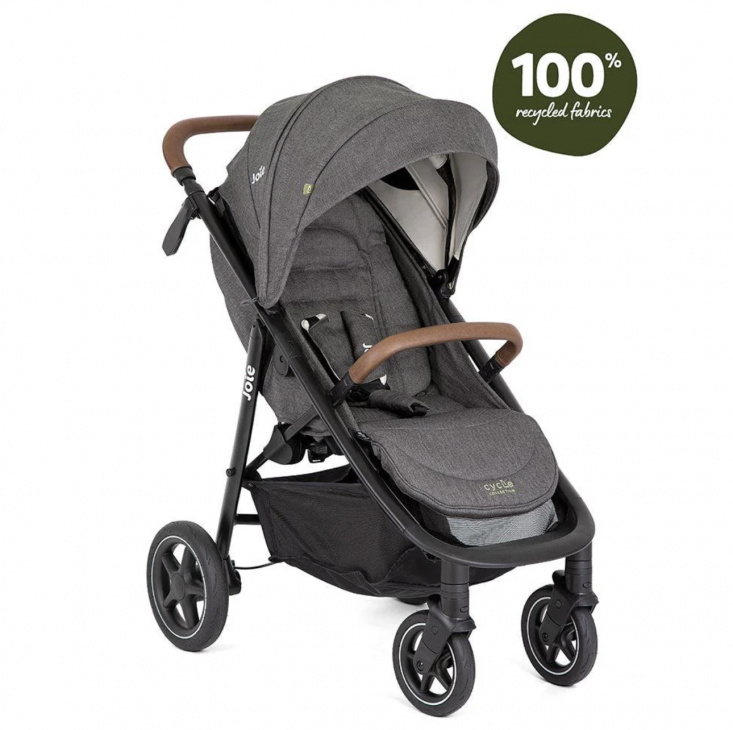
Joie Mytrax & Ramble XL Carrycot, £350
Joie really does deliver with the MyTrax, a great mid-sized buggy that offers a surprisingly smooth ride and some very cool features (like 100% recycled fabrics) at a very competitive price tag.
The pushchair itself has a seat that lies near-flat, but for your newborn I’d recommend paying the extra £130 for the luxurious Ramble XL carrycot, which you can clip onto the frame for a parent-facing option. Parents I’ve spoken to and worked with really rate this pushchair, which is also travel system compatible.
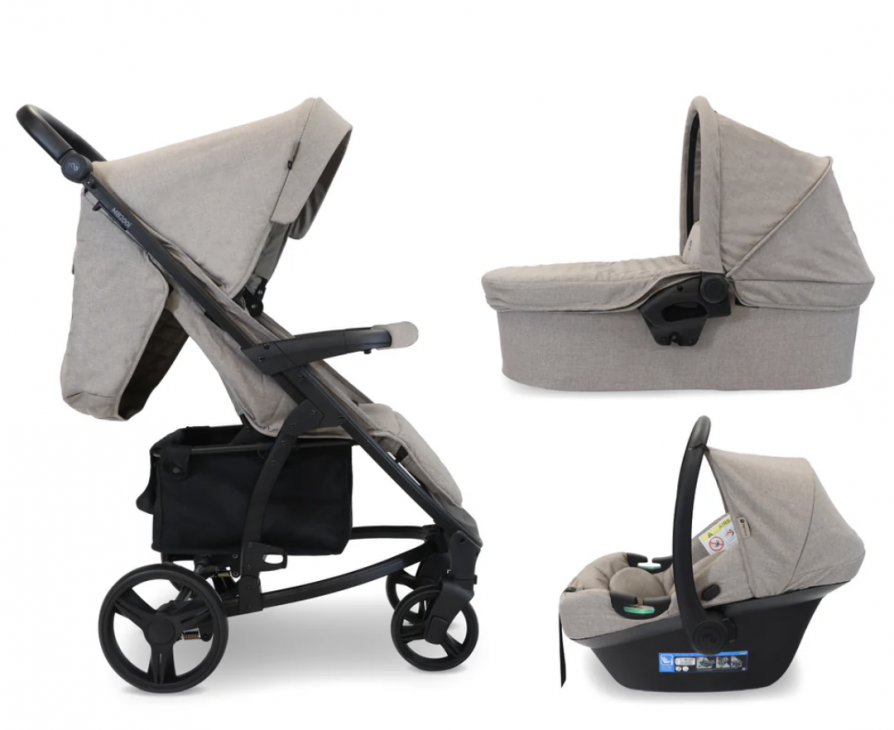
My Babiie MB200i Travel System, £249
A full travel system for under £250 is amazing value, and this model from My Babiie is a good entry-level option for those looking to save the pennies while getting everything in one bundle. The car seat is basic but is tested to the most recent R129 standard.
If you’re looking for the catch, the design isn’t the prettiest (the shopping basket in particular is a bit odd) and the seat can only be used world-facing mode. But you get a carrycot for the early months, and the 22kg weight limit of the seat is a bonus for a budget buggy.
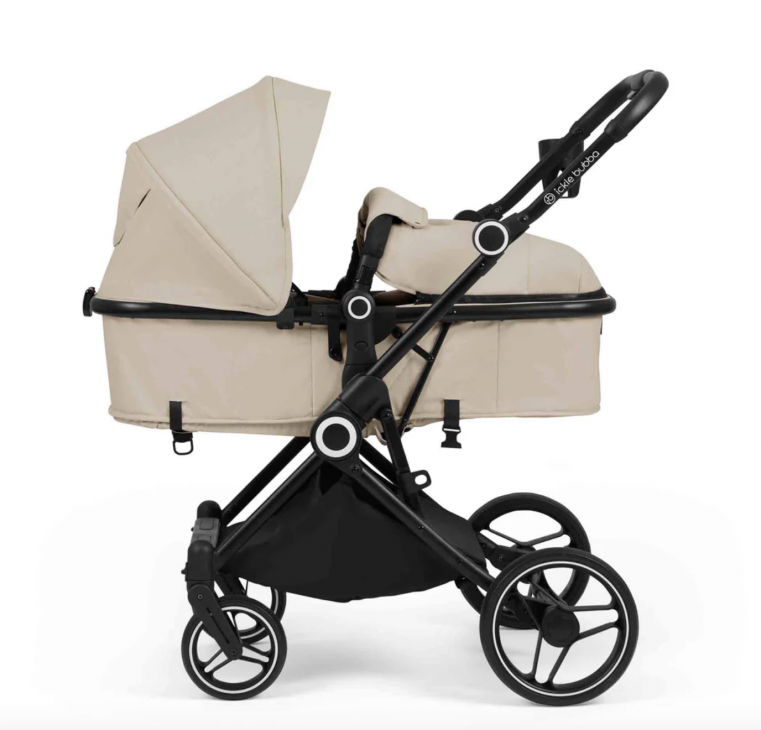
Ickle Bubba Atom 2-in-1 Pushchair, £269
This isn’t Ickle Bubba’s cheapest model – that would be the Star, which is just under £200 – but I”ve chosen this one because it has a higher 22kg weight limit, meaning this is more likely to last until your child outgrows a pushchair entirely, reducing the chances of needing to buy a stroller later down the line. I think that justifies the extra £70.
The carrycot converts into the seat using a clever set of clips and folding panels, so you don’t need to store any extra pieces once your child outgrows the pram. It’s also an impressively lightweight model – under 9kg – with a decent fold.
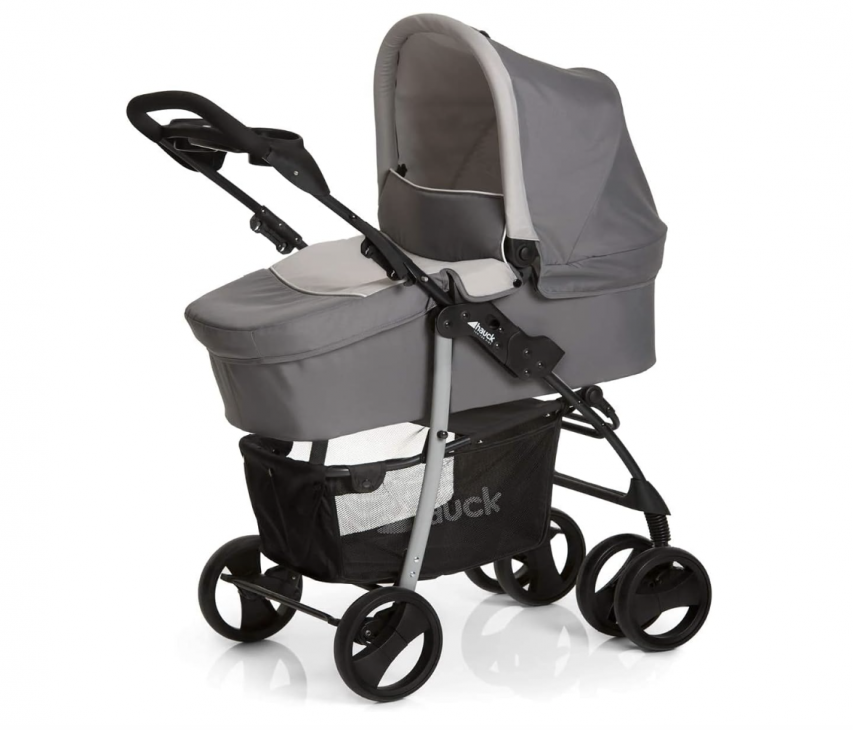
Hauck Shopper SLX Trioset Travel System, £196
It may not be the prettiest of the prams on this list, but if you want a buggy with good storage, Hauck’s aptly-named Shopper has a deep underseat basket, as well as a fun integrated cupholder and tray on the handlebar.
Sold as a travel system with integrated adapters, you’ll get a carrycot, seat unit and a car seat in this bundle for under £200. The pushchair folds admirably small with the seat on, and it’s got a 25kg weight limit (22kg for the seat and 3kg for the basket).
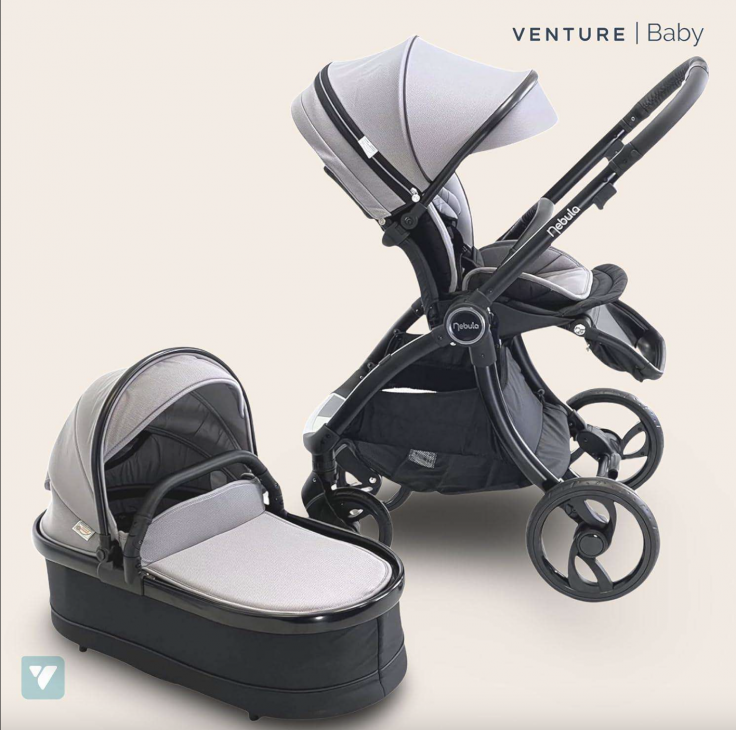
Venture Nebula 5-piece bundle, £249.99
Originally retailing at almost £500, this pushchair is a great find for under £250, especially given its sturdy wheels, luxe-looking carrycot and impressive extendable canopy on the seat unit. It’s got a 22kg weight limit, and the seat is really smartly-designed with a near-flat recline for naps.
Venture is a great brand to look out for if you’re on a budget as they often have great deals and produce models that have a lot in common with pricier brands. I really liked this pushchair when I tested it, and I also really rate their travel cot.
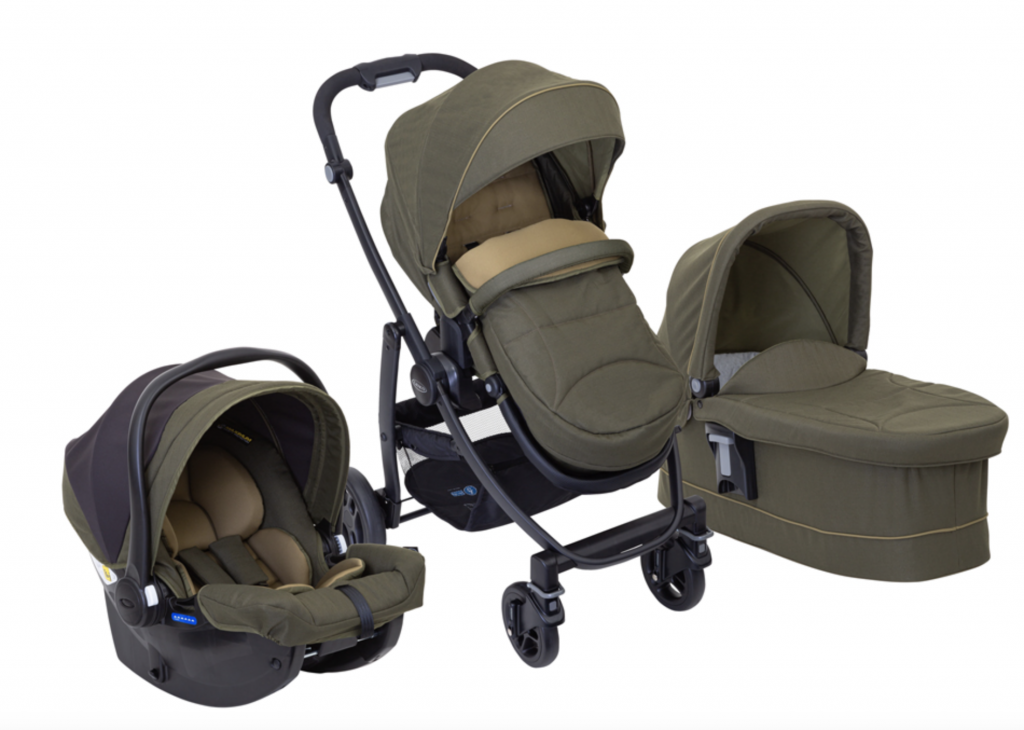
Graco Evo Trio Travel System, £349
This bundle is really good value at £349 including an i-size infant car seat. Graco is a brand I turn to a lot when recommending reliable but well-priced baby items: it’s part of the same stable as Joie and Nuna and has some great innovation in its competitively-priced products.
The Evo has a 15kg weight limit so lacks some of the longevity of other models in this list, but it has some handy benefits like a one-handed fold, a luxury carrycot and an i-size car seat.
A word on generic / non-branded pushchairs
A quick search on Amazon, Wish, Ali Express or similar marketplaces will bring up hundreds of budget prams and pushchairs that seem like a good deal. I don’t recommend products unless I have personal experience of them and/or good knowledge of the brand that manufactures them, and it’s impossible for me to try all these prams. When researching these prams, I’ve often spotted what I consider to be red flags, such as the brand name on the buggy being different to the one listed in the product information. It’s often difficult to find details of safety testing, max weight limits, dimensions etc as well, and I definitely wouldn’t use a car seat that came in one of these bundles. When it comes to baby safety, I have a responsibility when it comes to my recommendations, but I’d love to hear your experiences if you’ve tried one of these pushchairs.
3. A car seat
If you’re going to take your baby in a car at any time – even just home from the hospital – you will need a car seat. There are two main types to consider. The first is the classic infant carrier, which looks like a little baby seat with a handle. These seats usually last until around 12-15 months, depending on the size of your baby. This type of seat may be compatible with a travel system, and they’ll either fit into the car with a seat belt, or they’ll come with a base that you fit into the car using a system known as ISOFIX, which hooks onto loops built into the seat frame of your car. A couple of very new infant carriers have built-in ISOFIX adapters, but they’re expensive so don’t feature here.
The second type of seat is one with a built-in base that’s fitted into the car and designed to stay there. The downside of this is that you have to lift the baby in and out. The upside is that these seats are often much better value as they can last up to age 4, 7 or even 12. They may also have a minimum height limit which rules them out for babies who are born small. Some are not suitable until your baby is a few months old.
My favourite good value infant car seats
Car seats are difficult to recommend fully without knowing more about your lifestyle and budget, the car you drive and the size of your baby, so I’ve kept this list quite short. You can find my policy on car seat recommendations here. If you’re interested in more tailored advice, drop me an email.
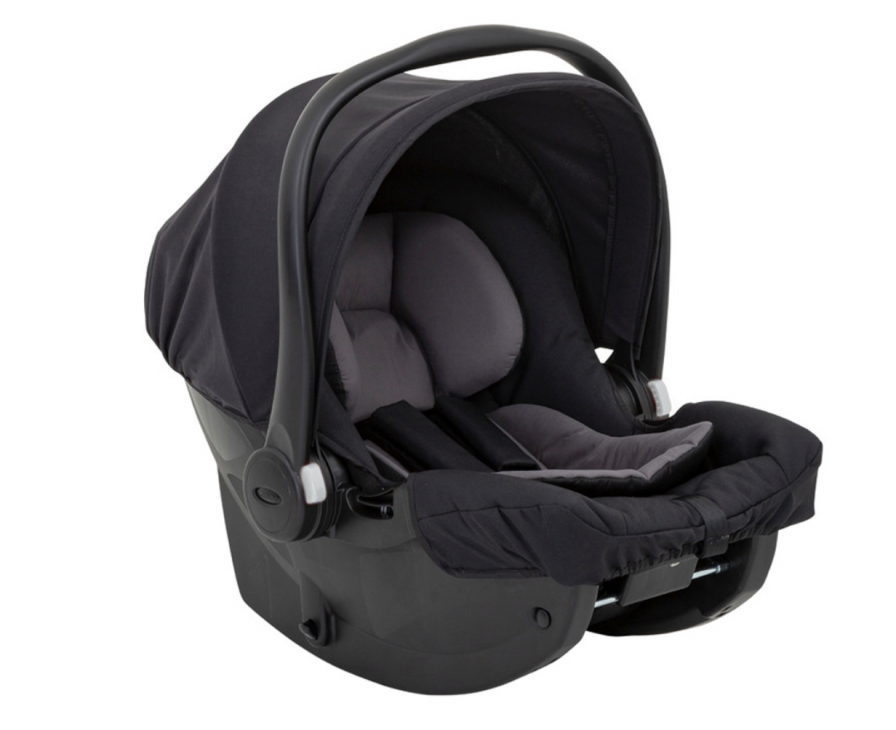
Graco SnugEssentials i-Size R129 Car Seat, £99
This is the car seat that comes with the Graco travel system I’ve recommended above, but it’s also worth flagging on it own, because for under £100 it’s a very serviceable infant carrier that has performed well in independent tests.
Like most car seats, there’s a knack to fitting this seat with a seat belt, but Graco has a good demo video. There’s a matching ISOFIX base (£100) if you’d prefer the ease of fitting that comes with ISOFIX.
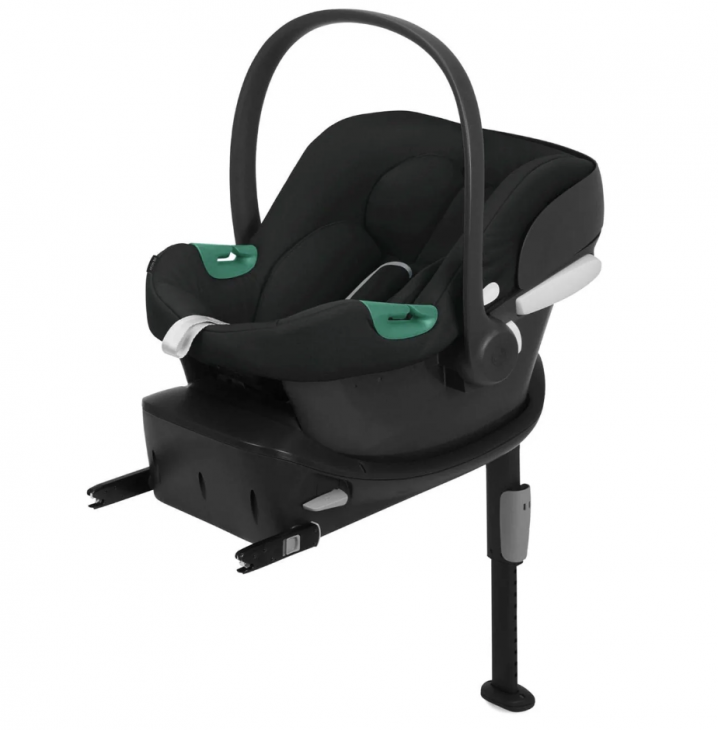
Cybex Aton B2 i-Size with Base One, from £175
I know £175 isn’t cheap, but this car seat gets a really good score from ADAC (a German motoring organisation that does reliable independent car seat testing) and has been praised by other consumer organisations too.
If you’re looking for something that is good value and can be trusted from a safety perspective, this is a good seat. This bundle contains the infant car seat and the ISOFIX base for your car, and Cybex says the seat should last until approx 24 months which is longer than a lot of infant carriers. The seat can be fitted with a seatbelt too, so if you need to move it between vehicles you don’t necessarily have to move the base.
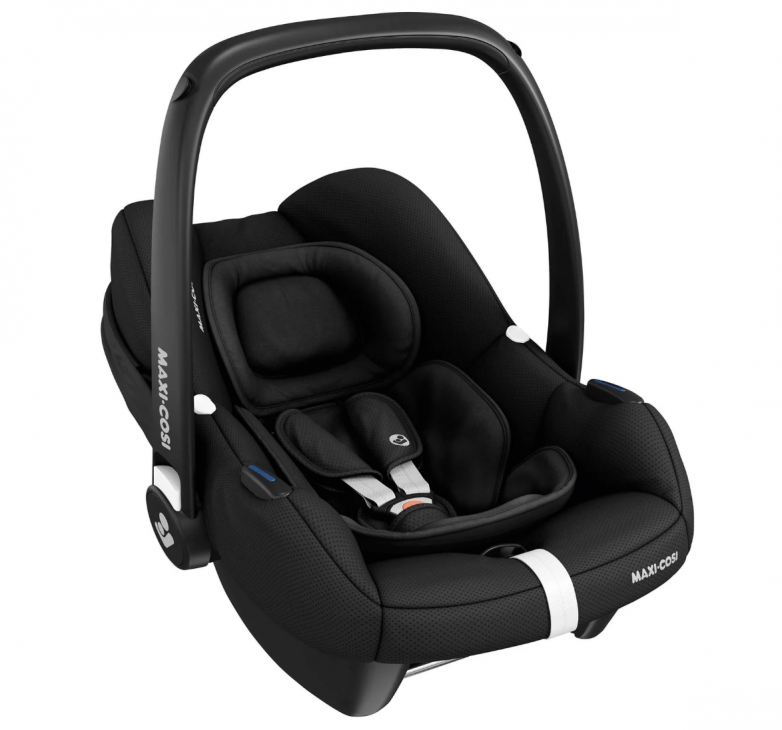
Maxi-Cosi CabrioFix i-Size Car Seat, £119.99
Like Cybex (above), Maxi-Cosi infant seats combine great functionality with convenience: they fit universal adapters so they can be clicked onto lots of different pushchairs.
The CabrioFix is the brand’s entry-level seat, but despite it’s lower price tag it still scores well in ADAC testing. It can be fitted using a car seat belt to save you needing to buy the base (if you do want it, the base is sold separately for a further £119.99).
If you want a good quality, affordable infant car seat to use on a travel system this one is a really strong choice at a good price tag.
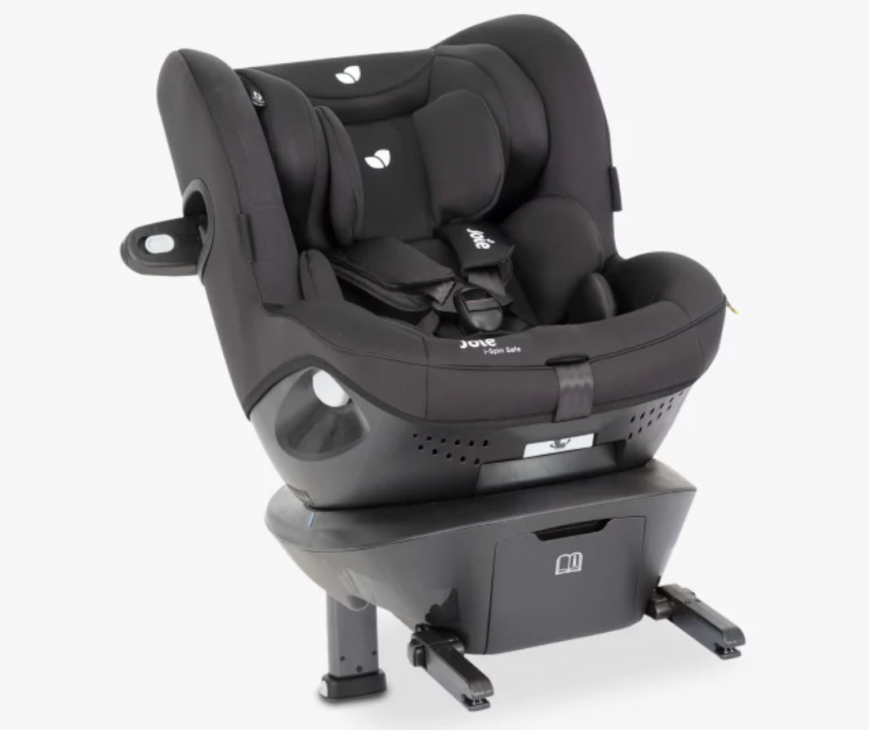
Joie i-Spin Safe i-size car seat, £314
I make it a rule to ensure any list of car seats – even a budget one – contains at least one seat that’s passed the voluntary Swedish Plus Test. It’s the most rigorous test a car seat can be put through, and it’s considered by many to be the gold standard of car seat safety.
The i-Spin Safe is a stationery car seat with a built-in base that will last until your child is 105cm. Assuming that’s around age 4, this works out at around 20p per day, which is about the same as the Cybex seat. It has spin technology to help you get your baby in and out of the car, but unlike similar models, the spin will not allow you to turn the seat forward-facing early. One of the reasons this passed the Swedish Plus Test is the fact it’s rear-facing only right up to age 4, which is proven to be safer.
A word on fitting your car seat
A recent report suggests that up to 70% of car seats are either unsuitable for the child, incorrectly fitted, or both. It’s of paramount importance that you measure your child’s height and weight frequently and adjust or upgrade when needed. It’s also important to make sure your car seat is fully compatible with your vehicle and fitted in the correct position.
Car seats are safety devices. They’re not always intuitive to fit. If possible, get expert help fitting your seat. If you can’t, study the instructions in detail. Most manufacturers also have online videos that show the steps in detail. Practice before your baby comes! If you’re using a seatbelt to fit the seat, ensure it’s routed correctly, the strap is not twisted and it’s pulled really tightly. Fitted correctly, a belted installation should be no less safe than ISOFIX, but there is a much bigger margin for error.
You also need to ensure your child is in the seat properly: this means the harness is not twisted, and it’s pulled nice and snug. Try to pinch the straps at the collarbone – if your fingers slide off, it’s tight enough. If you can pinch fabric, pull that harness tighter. Don’t put kids in the car seat in bulky padded coats or snowsuits, as these stop the harness from doing its job. Ensure you’re moving the headrest up and removing any inserts as they grow, so the straps are always at shoulder height (or just above/below depending on the manufacturer’s instructions). Don’t move up to the next seat until you need to – max out those height or weight limits to get the most from your seat.
4. A baby carrier
Babywearing is a great way to soothe your baby, keep them close, and transport them around easily. However, the prices of carriers vary hugely. Some fashion carriers can be upwards of £300, but it’s also easy to find decent ones for under £50. I’ve featured a couple here I love from reputable brands that I trust: these will not be the absolute cheapest on the market, but they are ones I stand behind for their value. This is a category where counterfeiting is rife so do be careful if a deal feels too good to be true.
I also really encourage you to look for second-hand baby carriers. A lot of families stop babywearing quite early, so some of these products have only been used for a few months – and they’re almost all washable. I picked up a LilleBaby Complete (which retails at around £100) for £10 on Facebook Marketplace. You can easily find Ergobaby carriers for around the £50 mark: a third of what they cost new. Other good brands to look out for second-hand include Tula, Baby Bjorn and Freerider.
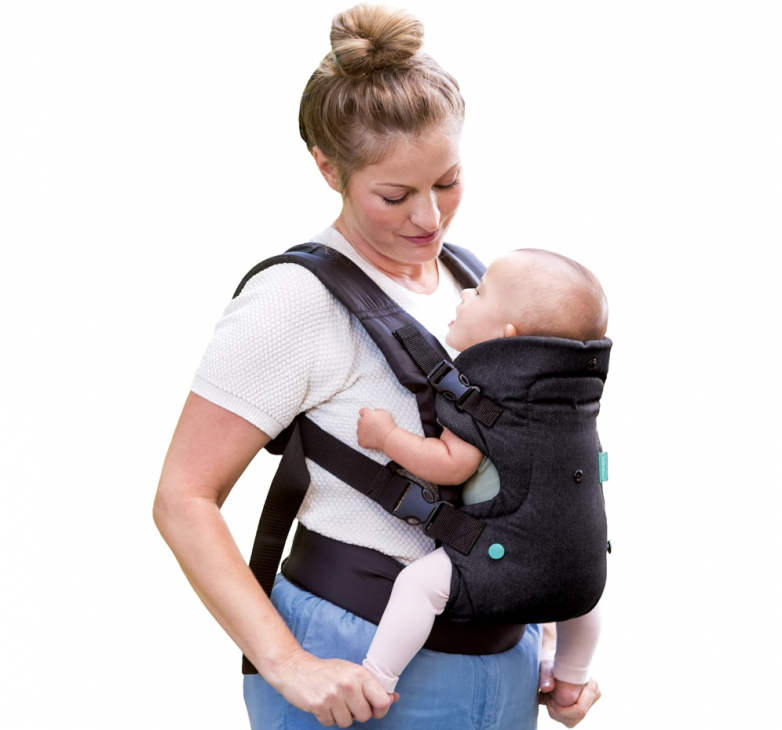
Infantino Flip Advanced 4-in-1 Carrier, £24.99
Infantino is my go-to for truly affordable carriers. For what you’re paying, the Flip really delivers with lots of useful details, decent padded straps and waist fastening, and the option to carry in 4 different positions. Obviously at this price you’re not going to get the softest most premium fabrics, and the lumbar support will be minimal, but you really can’t complain for £25. If you need a carrier but you’re not sure how often you’ll use it, this is a really great buy.
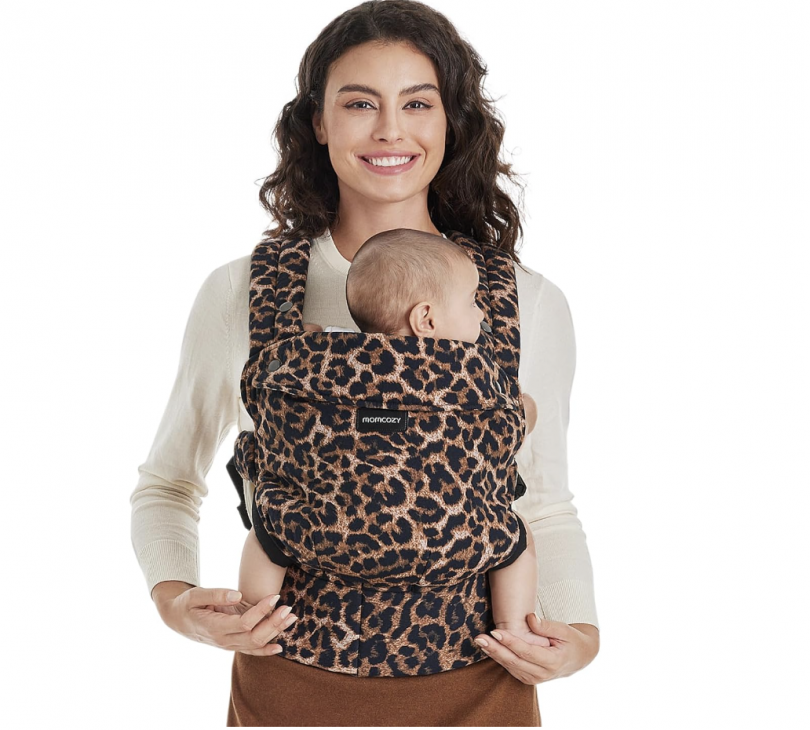
Momcozy Baby Carrier, £45.99
Oh, you know I was gonna squeeze in a leopard print carrier if I could! Just because you’re on a budget doesn’t mean you miss out on fun design details. Momcozy has really impressed me in the last couple of years, offering good value products in some of the key baby categories (the breast pump is really well-regarded). This design has a lot in common with carriers that cost 3 times as much. The padded straps (with crossover option) and folding neck support make this feel premium. For under £50 I think this is a total winner, but do note it won’t be suitable for a small newborn. This will be more useful once a baby is around 3-4 months old.
5. A baby monitor
A baby monitor is not a must have – generations of parents coped without them – but they are a very popular product and a helpful tool to provide reassurance to parents. You don’t need to be in a rush to buy one as your baby should be sleeping in the same room as you for the first 6 months, but I know a lot of parents do invest before the baby arrives, so I’ve chosen to include a few good budget ones here to help you in your search.
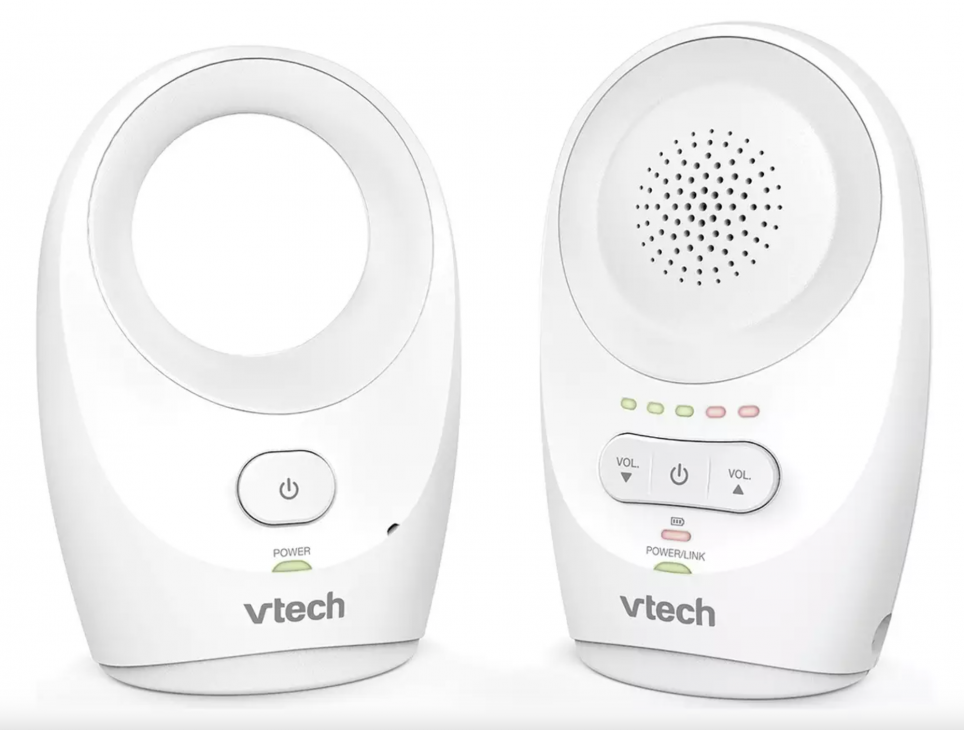
VTech DM1111 Audio Baby Monitor, £20
The cheapest option when it comes to baby monitors is an audio-only monitor. At £20, this is a no-brainer buy if you can spare the budget for it. Put the base unit near the baby and keep the parent unit with you, and it’ll alert you (with lights and sound) when your baby cries. Parents love the simplicity of this model as there’s no need for a WiFi connection, batteries last for ages and there’s a decent range of 450m.
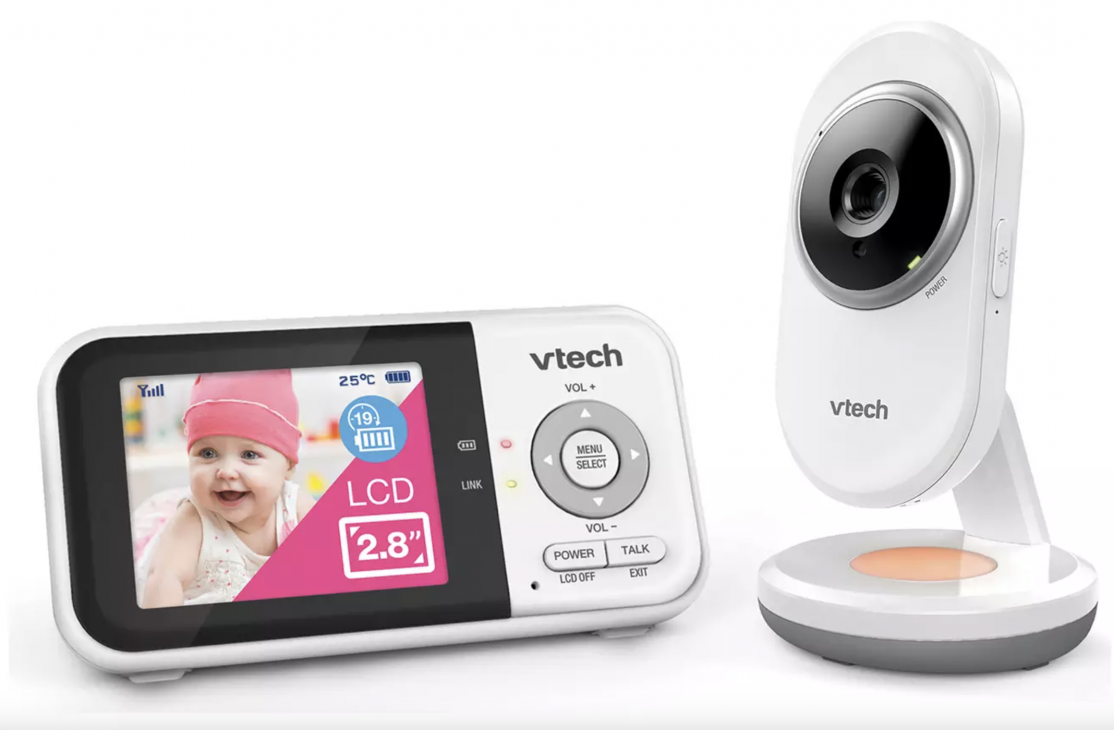
VTech VM3250 Video Baby Monitor, £43.99
Yes, it’s another VTech product, but for under £50 this video baby monitor is truly great value. I’ve used a number of VTech monitors myself and trust them to do a good job at a good price. This isn’t going to wow you with interactive features and movement monitoring, but it does offer a clear picture, a decent battery life and a simple to use interface. It operates without Wi-Fi, has a 300m range, 2-way talk, and a temperature sensor. I also like that the camera itself can be angled: a lot of cheaper models are fixed
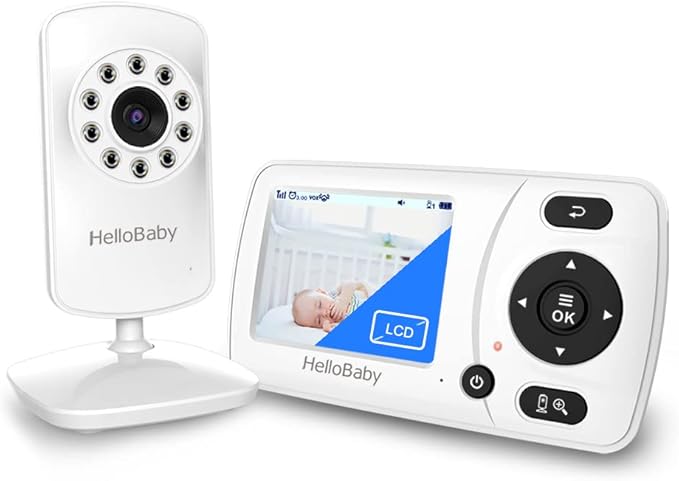
HelloBaby Wi-Fi-free Baby Monitor, £39.99
This camera retails at £50 but it’s usually on offer, and is another reliable entry-level video monitor. The screen, camera and features are all similar to the VTech above, and it’s also Wi-Fi free, which a lot of parents prefer for privacy/safety reasons. The interface is quite basic but does include some fun additions like a feeding timer (although I’d wager your babies cries are much better for that).
6. A steriliser
Guidance on sterilising in the UK is quite strict, with the NHS advising that all feeding equipment is sterilised until a child is 12 months old. This include bottles, breast pump parts, nipple shields, dummies and so on, so most families will need to get used to the process. The NHS also clearly states that a dishwasher is not enough. Even if you wash items there, they need to be sterilised afterwards.
The old-fashioned way to sterilise is to boil items in a large pan of water for at least 10 minutes. This requires no extra equipment, but with utility bills as high as they currently are, may not be the cheapest solution in the long run. I prefer one of the below methods.
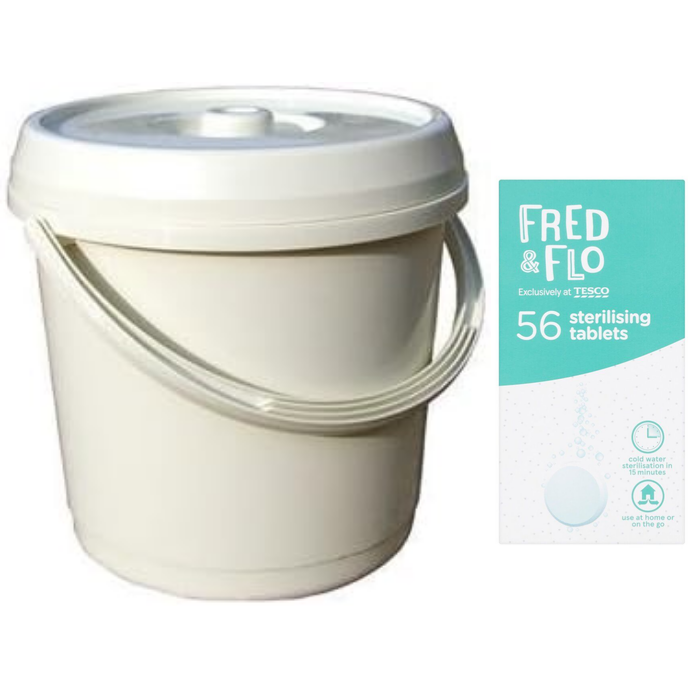
Cold water sterilising, from around £20
Cold water sterilising uses sterilising tablets (or liquid) added to cold water. Milton is the most popular brand, but supermarkets sell their own brands for even cheaper – a box of 52 tablets from Tesco is £1.65. The sterilising tablet dissolves in water making it sterile, you then dunk your feeding items and they’re ready in about 15 mins.
You can use any bucket you want, or even sterilise in a clean sink. Milton sells a special bucket with a compressor and locking lid that I really like, but here I’ve just included a basic lidded bucket. You need to change the water and use a new tablet every day, so to sterilise for 12 months, you’ll need to budget for at least 7 boxes of tablets.
The upsides of cold water sterilising (other than the price) are that it’s easy, and you can add and remove items all day long. On the downside, the items come out wet (this is safe, just messy) and the water has a very strong swimming pool-like smell which some people don’t like.
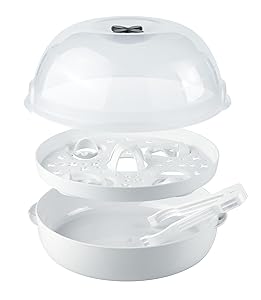
Nuk Micro Express Plus microwave steriliser, £24.99
If you have access to a microwave, using it as a steriliser is both quick and convenient. Nuk’s microwave steriliser is often on offer for as little as £15, and is good if you need to quickly sterilise just a few items.
Convenience and speed are big pros of microwave sterilisers, but on the downside they are very small and only hold a couple of bottles at best. They’re often designed to hold a specific brand of bottle – and you won’t know which brand of bottle your baby likes (if any!) until they arrive.
Some bottles (and even dummies) can be sterilised in the microwave without a separate bowl or box, so check this before you buy. Mam products are famous for this feature.
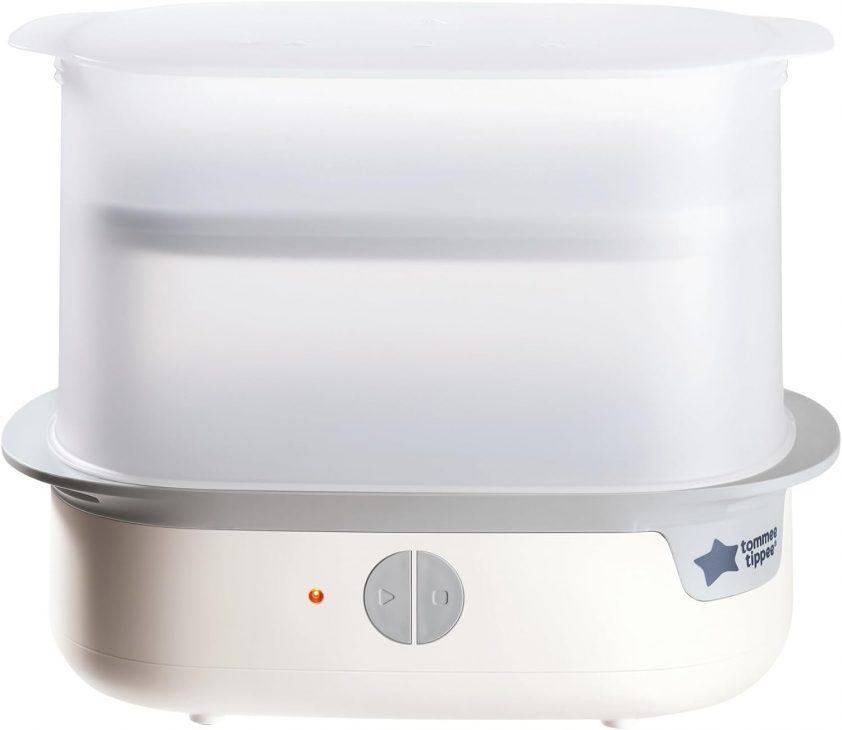
Tommee Tippee Advanced Steam Electric Steriliser, around £50
Once you get into the realms of electric sterilisers, prices go up dramatically. There are all-singing, all-dancing steam and UV sterilisers and dryers that go for hundreds of pounds, but we’re on a budget here, so if you’re looking for an electric model, this one is your best bet as it’s usually on offer for under £50 despite an RRP of £74.99.
With two levels to hold plenty of bottles, pump parts and other bits, it’ll sterilise with steam in 5 minutes. Items only officially stay sterile until you open the lid, so you may find yourself running it quite frequently: bear this in mind when it comes to utility bills, and ventilate the house to stop any damp. You’ll also need to descale it (with vinegar) frequently, especially if you live in a hard water area.
7. Nappies & Wipes
There are two or three options when it comes to your baby’s hygiene. The first option is the most popular and arguably the most convenient: disposable nappies. The second is reusable or cloth nappies. You may also be interested in a more experimental method such as Elimination Communication (EC), which aims to potty train almost from birth, reducing the overall cost of either of those products. It’s a big undertaking, but if you’re interested in giving it a go there are some good resources available from The Nappy Lady, Go Diaper Free and The Bump.
For now, I’m going to assume most readers are making a decision between disposable and reusable nappies.
Disposable nappies
Disposable nappies are widely available and the simplest and most popular option. They are easy to use and very convenient. On the downside, they are costly and notoriously bad for the environment. More environmentally friendly disposable nappies are available, but do tend to be more expensive. The entry-level option here would be Kit & Kin eco nappies, which work out around 22p each depending on how you purchase (subscriptions/bulk buy works out better value).
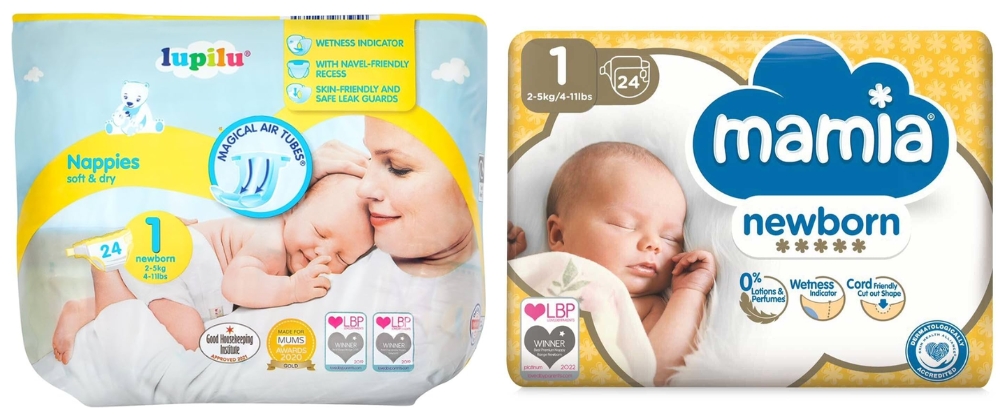
If budget is your number one concern then your cheapest option will be bulk-buying nappies from a budget supermarket, where nappies can be as little as 3p each. Both Aldi and Lidl nappies perform really well in testing, and I thoroughly recommend either if you’re on a budget. Unfortunately you will probably still spend a lot of money on nappies in the first few years because you just need SO MANY, but rest assured you won’t be getting a substandard product. There is a slight difference between a budget and premium brand, but if money is tight, it probably isn’t worth splashing out, especially at the newborn stage. If you do have some wiggle room in budget, try the more premium nappies at night as your baby begins sleeping longer stretches and see if they make a difference.
Cloth nappies / reusable nappies
Cloth nappies have enjoyed a resurgence in the last decade or so which is amazing news for a number of reasons, not least the environmental impact. However, understanding the market can be overwhelming as a new parent as there is just so much out there.
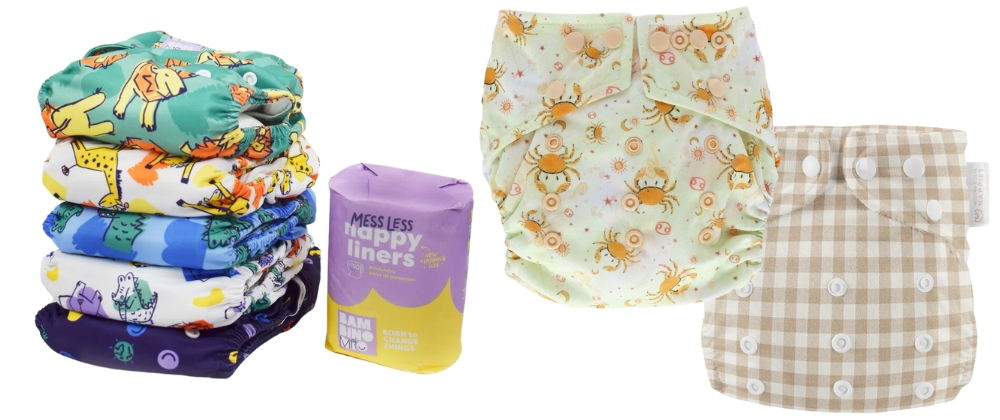
Our parents or grandparents may have been pinning together triangles of terry towelling, but the cloth nappies of the 2020s are a whole different beast. They have velcro, removable inserts, elasticated gussets and come in all manner of beautiful prints and fun patterns. The issue is knowing where to start. Building your “stash” can mean a big outlay in the first instance. Plenty of people have crunched the numbers and there is absolutely no doubt you will spend a lot less on cloth nappies than you would spend on disposables across the whole time your baby is in nappies. But with cloth the spend tends to come in one or two big purchases early on. With disposables, it’s spread out over a few years, which may be better for your budget.
Something else that’s come into play in the last few years is an increase in energy costs associated with laundering these products. High energy bills are an issue here because most cloth nappies need to be washed at quite a high temperature (60°C), and you may need specific detergent. However, advocates for this kind of product have found loads of economical ways of making this work, and it is really important that we consider the environmental impact of disposable nappies versus cloth nappies when making the choice.
If cloth nappies intrigue you, please do try them. The more of us that do it – even part-time – the more it’s going to drive change. A number of beautiful cloth nappy companies have folded since I had my baby, no doubt as a result of the pandemic and the cost of living crisis, and that is a crying shame as this can be a really cost-effective solution that also helps protect our planet.
My go-to brand for easing into the cloth nappy world is Bambino Mio, which offers starter kits and simple-to-use products that don’t require too much specialist care. Modern Cloth Nappies and Little Lamb are also great brands to consider.
Can I use second-hand cloth nappies?
Some people are unsure about second-hand reusable nappies, but there’s actually a big market for them. If you have family members who use cloth nappies back in the day, you’ll probably find they were used for multiple siblings. Used correctly, they are washed at high temperatures which sanitises them. The fabrics that good quality cloth nappies are made from actually get softer and more absorbent after being washed multiple times, so second-hand ones can be a great investment provided they’ve been well cared for. Many people also buy reusables to try, but never fully commit, so there are plenty of nearly-new options out there too.
Specific nappy groups and local jumble / nearly new sales are often the best place to look, but there’s also a thriving market for cloth nappies on Facebook marketplace. Vinted will only allow brand new ones to be listed at present.
If hygiene is still a concern, there’s a specific method called “strip washing” that you can do to essentially ‘reset’ reusable nappies and ensure they’re fully sanitised and ready for your baby.
Cotton wool and baby wipes
During nappy changes, you’ll need something to clean your baby’s bottom. You can start with lukewarm water on 100% pure cotton wool, and this is especially good in the first few days as the dark, sticky poos of newborns (meconium) can be tricky to clean up without a lot of water. Parents will generally move to wipes a few weeks in, but there’s no need to do it. When and if you do, just make sure they are labelled as suitable from birth.
When buying wipes, they should be plastic-free (plastic wipes are set to be banned in the UK) and ideally biodegradable. I try not to preach too much about environment but this really is the least we can do, especially if we’re using disposable nappies. Lidl sells good biodegradable wipes for 69p a pack, so being on a budget shouldn’t be a barrier.
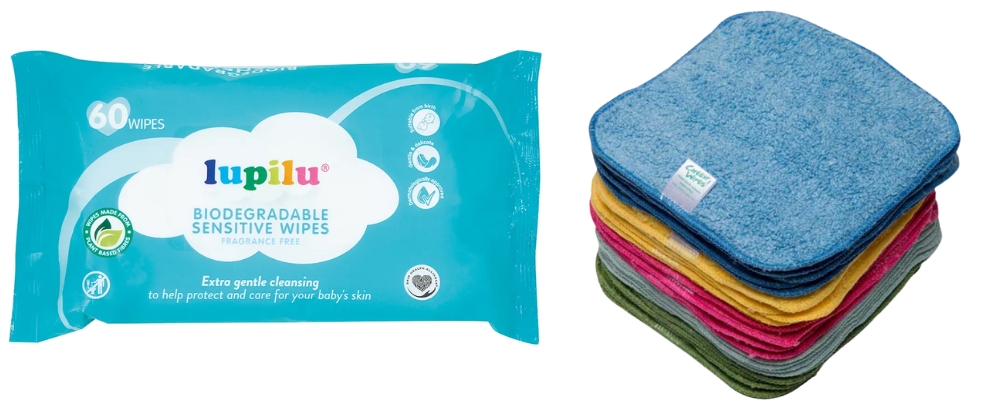
In my experience, as with nappies, there’s not enough difference between a budget and a premium wipe to justify spending more if you’re trying to save money. No wipe is perfect, and as most brands move to a more environmentally-friendly product, you’re really just buying water-soaked fibres whether you spend 60p or £2 on a pack. A common complaint is that they’re hard to get out of the pack: a great tip is to put a hair tie around the pack, over one side of the hole. This slows them down as you pull so you don’t take 3 at a time when 1 will do.
Cloth wipes are the other option. Not only are they better for the environment, they also give a much more thorough clean. If you don’t fancy dealing with them for nappy changes, I definitely recommend them for hands and face once you start weaning – it’s so much easier to get your baby clean after a meal. Obviously they do need washing (at high temperatures) but chuck them in with your muslins and/or cloth nappies if you’re using them, and it just becomes part of the routine. Cheeky Wipes has the market sewn up in the UK and their starter packs are really great, you can get a basic one for £19.99. Or you can make your own using old towels, blankets, muslins or similar.
I hope I’ve covered all the obvious big ticket items in my list, but if there’s anything else you’re struggling to find on your hunt for budget baby items, do let me know. I’m always looking for ways to upgrade and improve these guides.

